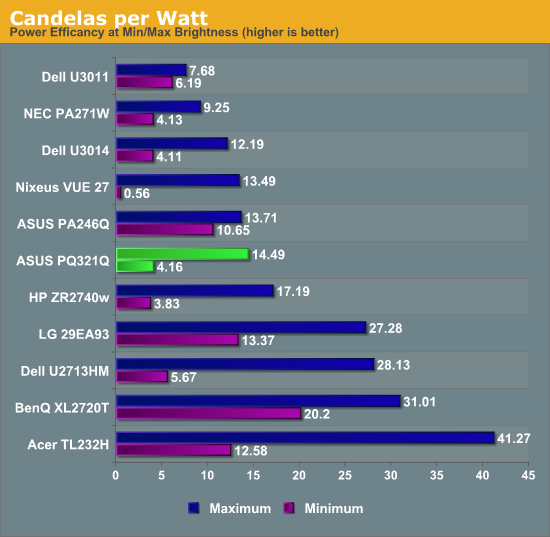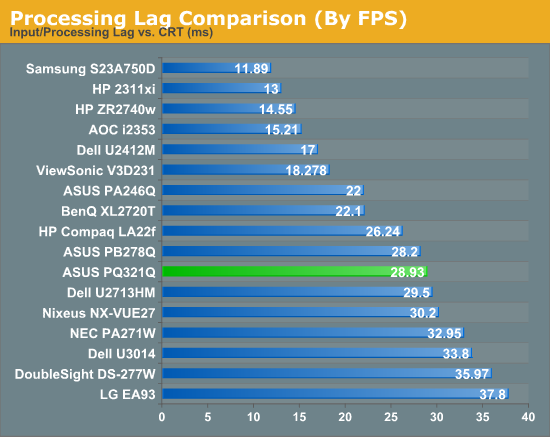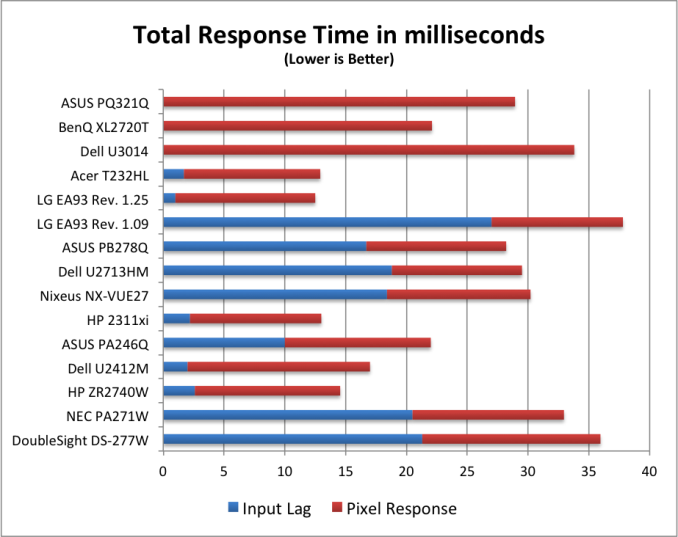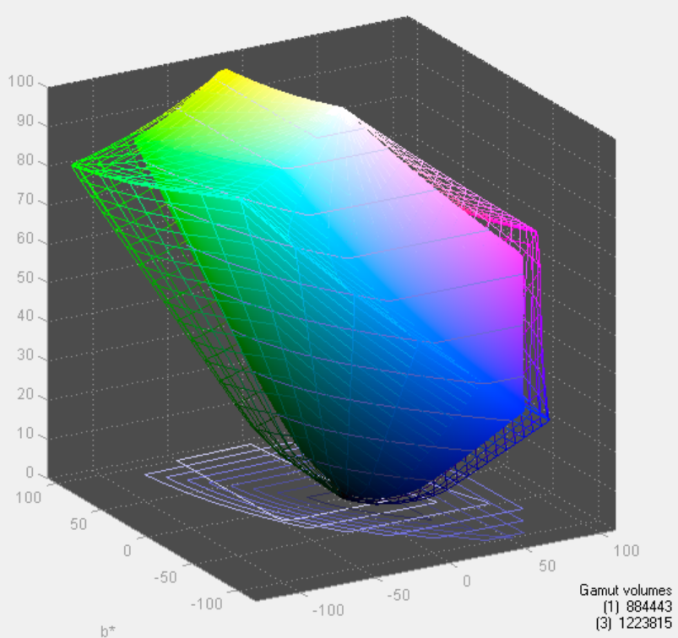ASUS PQ321Q UltraHD Monitor Review: Living with a 31.5-inch 4K Desktop Display
by Chris Heinonen on July 23, 2013 9:01 AM ESTUsing the updated metric for power usage, where I factor in maximum brightness and screen area and not just power usage, the ASUS PQ321Q falls right in the middle of the pack. For both maximum and minimum brightness it does OK but not incredible in comparison to other displays. With the greater transmission of IGZO I would have thought I might see better numbers from the ASUS, but I imagine power usage was very low on the list of concerns relative to other performance numbers.
Overall the ASUS PQ321Q draws a relatively average amount of power compared to other displays.


For testing input lag, I’m again reduced to using the Leo Bodnar lag tester over HDMI. This also means that the ASUS will have to scale the 1080p signal to be 2160p and fill the screen. Unlike before, I think this might be a more accurate test as many people will not be gaming at 2160p yet. Looking at the gaming numbers that our Ian Cutress found with a 4K display, you might want to run at 1080p for a little bit until setting up a 4x Titan rig becomes more affordable. Then again, if you can afford the ASUS PQ321Q, you might be buying a 4x Titan setup as well.
Back to the actual data, and the ASUS comes in at 28.93 ms of lag on average for the 3 measurement locations. This is better than the Dell U3014 monitor does, but slower than the BenQ XL2720T that is a native 1080p display. Given that you have scaling going on here, this actually is a pretty decent result I think.

Despite my GPU only being a GTX 660 Ti, I did try out a little bit of gaming on the ASUS. One question that was debated in Ian’s round-up was the necessity of MSAA at 4K resolutions. Measuring just now, I sit exactly 2’ away from the ASUS PQ321Q, with my eyes around dead center on the display. Turning on Half Life 2 (look, I’m not much of a gamer!), I can easily see the difference between no MSAA, 2x and 4x MSAA. The pixel density would need to be even higher, or I’d need to sit further away, for MSAA to not make a difference.
Without MSAA things still looked very sharp overall, but jagged lines are easy to spot if I look for them. You might be able to more easily get away with 2x or 4x instead of 8x MSAA, but you’ll want to have it enabled. Beyond that, the PQ321Q worked well for my casual gaming. Nothing recognized the display correctly at first, perhaps because of MST, but once in the game you can properly select the 3840x2160 resolution for it.
At the request of a commenter I'm adding some PixPerAn photos, trying to show best and worst case results. I've not used PixPerAn at all before, so feedback would be great. If I've done something wrong with it, I'll try to correct it ASAP.
Looking at the gamut, we see a value that indicates full sRGB gamut coverage. From our earlier images of the CIE diagram we know we don’t have full coverage of red, blue and magenta. It seems the extra green/yellow/orange section is large enough that we get a value that indicates a volume equal to the sRGB space, but some of that volume is an area outside of sRGB. It is close to the sRGB area, but not quite.


















166 Comments
View All Comments
Zan Lynx - Thursday, July 25, 2013 - link
On the other hand, if you are building a $3,500 display you may as well throw some speakers in there. A graphics artist might like the picture but only want to play the occasional email or IM notification sound.DanNeely - Thursday, July 25, 2013 - link
At the same time, for that sort of use an optional speakerbar is a reasonable accessory without driving the price up for those of us who'll never need it.kenour - Thursday, July 25, 2013 - link
*yawn* Can someone wake me when a 1600p @ 24" @ 120hz monitor is released.tackle70 - Thursday, July 25, 2013 - link
I am so jealous of anyone with a spare $3500 laying around to spend on this screen. I am just dying to move from my 27" 1440p panel to a 4k 60 Hz screen... I'm really hoping the 39" type VA panel that ASUS has coming out next year is a lot cheaper.skrewler2 - Friday, July 26, 2013 - link
Pretty disappointing a $3500 monitor doesn't come with a stand that pivots (portrait mode). Wonder if the 4k Dells will come with it...houkouonchi - Monday, July 29, 2013 - link
"We have seen non-IGZO panels in smartphones with higher pixel densities, but we don’t have any other current desktop LCDs that offer a higher pixel density than this ASUS display"Wha??? I have been using 22 inch 4k LCD's since 2005-ish that have way higher pixel density than this thing does...
dj christian - Tuesday, July 30, 2013 - link
What does this gamma, contrast and db2000 all mean?path_doc - Wednesday, July 31, 2013 - link
Can the "NVIDIA GeForce GT 650M 1024 MB" graphics card that the Macbook Pro retina has drive this display? If not then do I have to buy a separate desktop to do the job?path_doc - Thursday, August 1, 2013 - link
Anyone out there?DPOverLord - Wednesday, August 7, 2013 - link
Reading this there does not seem to be a reason to buy it. Someone is better off buying 3 30" 1600p monitors for 3k than 1 31.5" 4k monitor for the same price. Thoughts?